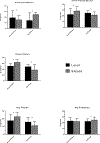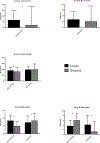Lower extremity kinematics of cross-slope roof walking
- PMID: 30509518
- PMCID: PMC6401559
- DOI: 10.1016/j.apergo.2018.09.013
Lower extremity kinematics of cross-slope roof walking
Abstract
Working conditions of residential roofers expose them to a unique sloped environment. The purpose of this study is to determine in what way traversing across a sloped/roof surface alters lower extremity kinematics of the upslope and downslope legs compared to level walking. College aged males negotiated across a pitched (26 degrees) roof segment during which lower extremity three-dimensional kinematics were calculated. One foot was higher on the slope and one was lower for the duration of cross slope walking. Overall, cross-slope walking on a 26 degree roof significantly altered 77% of the measured lower extremity variables compared to level self-selected pace walking. The data suggest that roof pitch incite significant differences in crossslope walking of the kinematics in the lower extremity between the upslope and down slope limbs when compared to level surface walking. These alterations could temporarily alter proprioception which may in turn lead to increased falls and musculoskeletal injury, though further study is needed.
Keywords: Cross-Slope; Kinematics; Lower Extremity; Roof.
Published by Elsevier Ltd.
Figures





References
-
- Andres RO, Holt KG, Kubo M, 2005. Impact of railroad ballast type on frontal plane ankle kinematics during walking. Appl. Ergon 36, 529–534. - PubMed
-
- BLS, 2013. Nonfatal Cases Involving Days Away from Work: Selected Characteristics 2011 forward.
-
- BLS, 2015. Occupational Requirements Survey, Physical Demands Bureau of Labor Statistics; http://www.bls.gov/ncs/ors/physical.htm.
-
- BLS, 2016a. In: Labor D.o. (Ed.), Census of Fatal Occupational Injuries Charts, 1992–2014 (Revised Data
-
- BLS, 2016b. In: Labor D.o. (Ed.), Nonfatal Occupational Injuries and Illnesses Requiring Days Away from Work
MeSH terms
Grants and funding
LinkOut - more resources
Full Text Sources

